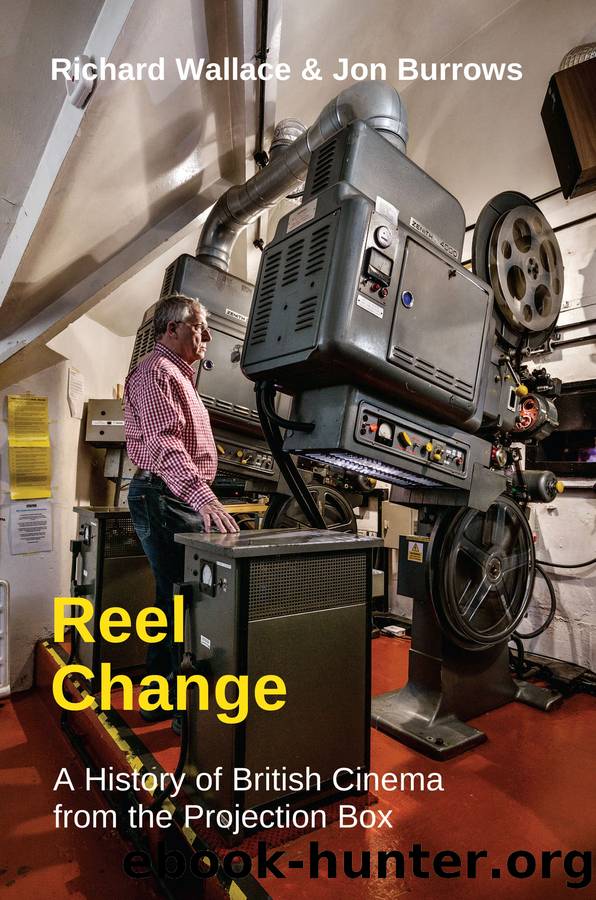Reel Change: A History of British Cinema from the Projection Box by Richard Wallace and Jon Burrows

Author:Richard Wallace and Jon Burrows
Language: eng
Format: epub
Publisher: John Libbey Publishing Ltd
Published: 2022-07-16T00:00:00+00:00
Organisation Without Unions
As we have explained in Chapter One, the introduction of synchronised sound equipment in British cinemas from 1929 onwards changed the job of projection in several respects. Presenting a successful show became a significantly more difficult task, and the responsibilities of equipment maintenance were expanded and grew more exacting. The number of operators needed in a single cinema increased, and, in taking over from musicians the responsibility of delivering sound accompaniment, they now more firmly constituted âthe heart and soul of the theatreâ, as one commentator put it.405 One might reasonably expect that improved terms and conditions of employment would follow such a considerable enlargement of duties, but, for the most part, this did not happen.
The small number of positive developments for employees that did accompany the transition to sound were confined to particular regions and ended up being short-lived. It had long been argued that the persistent âprice-cuttingâ that kept operatorsâ salaries low was directly linked to the âhaphazard system of engaging and training newcomersâ followed throughout most of the sector.406 It was therefore broadly welcomed that the new challenges of mastering sound equipment led to the inauguration of a small number of substantial training initiatives. Several leading American distributors â Paramount-Famous-Lasky, Jury-Metro-Goldwyn, Fox, First National-Pathé, United Artists, Universal and Warner Brothers â joined forces to fund a training facility in London for teaching operators how to handle sound films.407 Twenty-five hours of instruction were intensively packed into a two-week course, on which forty students were enrolled at a time, with classes taking place in the mornings before cinema opening times.408 Certificates were awarded to successful graduates, and the editor of the Kinematograph Weekly predicted that âExhibitors ⦠will not be slow in showing their appreciation of an operator who carries this hall markâ.409 However, despite reports of there being long waiting lists of keen applicants to the scheme, only 277 projectionists were given training during its lifespan, and it was wound up within a year.410 The experiment was not repeated anywhere else in England at this time. Places advertised for a similar training enterprise set up by the North West branch of the CEA were oversubscribed by 150%, but it did not get off the ground.411 The anticipated rise in salaries never materialised, despite a significant expansion of working hours. A correspondent signing himself âA Slave of the Lampâ claimed in a letter to the leading trade paper that he had âbeen over twenty years in the operating-box under all sorts of conditions right from the penny show up to the super kinema of 1930, and I can truly say that never in my whole experience have I ever known conditions so appalling as they are at the present momentâ.412
Download
This site does not store any files on its server. We only index and link to content provided by other sites. Please contact the content providers to delete copyright contents if any and email us, we'll remove relevant links or contents immediately.
Kathy Andrews Collection by Kathy Andrews(11669)
The remains of the day by Kazuo Ishiguro(8730)
Paper Towns by Green John(5018)
Spare by Prince Harry The Duke of Sussex(4985)
The Body: A Guide for Occupants by Bill Bryson(4871)
Industrial Automation from Scratch: A hands-on guide to using sensors, actuators, PLCs, HMIs, and SCADA to automate industrial processes by Olushola Akande(4816)
Machine Learning at Scale with H2O by Gregory Keys | David Whiting(3933)
Be in a Treehouse by Pete Nelson(3871)
Harry Potter and the Goblet Of Fire by J.K. Rowling(3731)
Never by Ken Follett(3695)
Goodbye Paradise(3656)
Into Thin Air by Jon Krakauer(3253)
The Remains of the Day by Kazuo Ishiguro(3245)
The Cellar by Natasha Preston(3209)
The Genius of Japanese Carpentry by Azby Brown(3183)
Fairy Tale by Stephen King(3147)
120 Days of Sodom by Marquis de Sade(3107)
Drawing Shortcuts: Developing Quick Drawing Skills Using Today's Technology by Leggitt Jim(2956)
The Man Who Died Twice by Richard Osman(2946)
